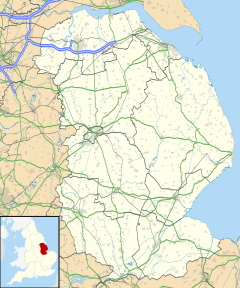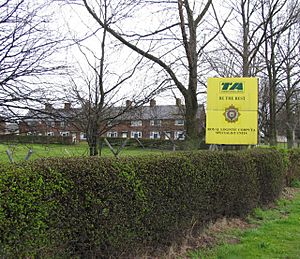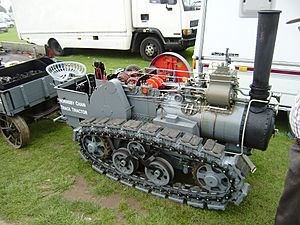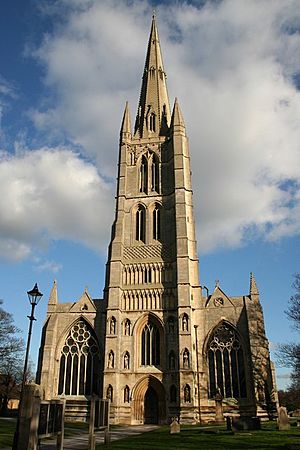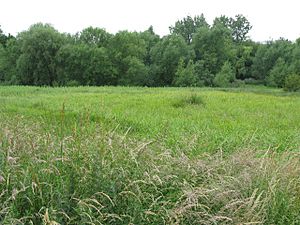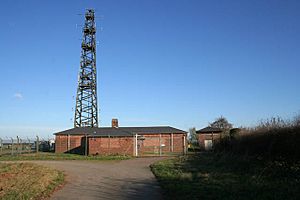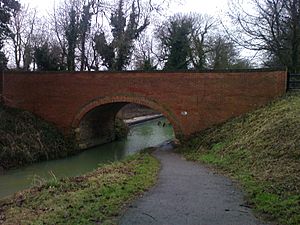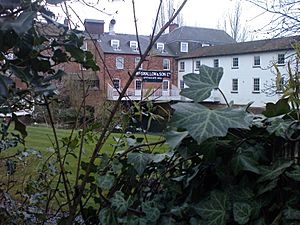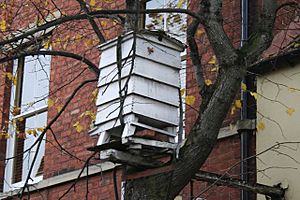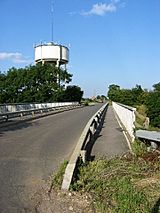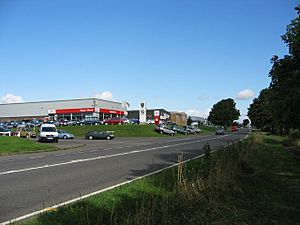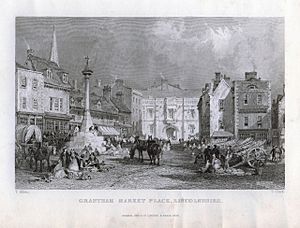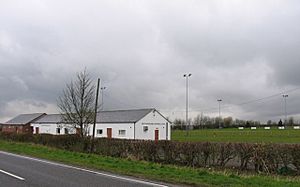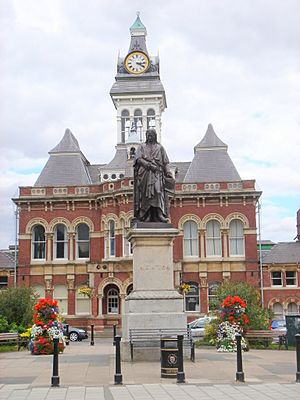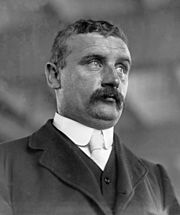Grantham facts for kids
Quick facts for kids Grantham |
|
|---|---|
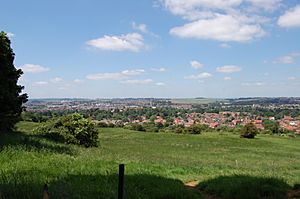 Grantham as seen from nearby hills and hollows |
|
 Coat of arms of the former Grantham Borough Council |
|
| Population | 44,580 (ONS, 2016) |
| OS grid reference | SK9136 |
| • London | 100 mi (160 km) S |
| District |
|
| Shire county | |
| Region | |
| Country | England |
| Sovereign state | United Kingdom |
| Post town | GRANTHAM |
| Postcode district | NG31–NG33 |
| Dialling code | 01476 |
| Police | Lincolnshire |
| Fire | Lincolnshire |
| Ambulance | East Midlands |
| EU Parliament | East Midlands |
| UK Parliament |
|
| Website | Visit Grantham, South Kesteven District Council |
Grantham is a market and industrial town in the South Kesteven district of Lincolnshire, England, straddling the London–Edinburgh East Coast Main Line and the River Witham and bounded to the west by the A1 north–south trunk road. It lies some 23 miles (37 km) south of the county town, Lincoln, and 22 miles (35 km) east of Nottingham. The population in 2016 was put at 44,580.
Grantham was the birthplace of the UK Prime Minister Margaret Thatcher. Isaac Newton was educated at the King's School. The town was the workplace of the UK's first female police officer, Edith Smith in 1914. The UK's first running diesel engine was made there in 1892 and the first tractor in 1896. Thomas Paine worked there as an excise officer in the 1760s.
Contents
History
Origin
The origin of "Grantham" is uncertain, although the name is said probably to be Old English "Granta+ham", meaning "Granta's homestead". It appeared as early as 1086 in the Domesday Book in its present form of Grantham, but was also recorded variously as Grandham, Granham and Graham. The place name element grand could possibly mean "gravel".
The name of the town is the origin of the Scottish surname, now often used as a given name, Graham.
Prehistory
Late neolithic vessels from a burial were found at Little Gonerby, in the north of the town, in 1875. A number of flint blades have been found, including from near Welham Street to the south-east of the town centre and from near Barrowby where a macehead has also been found. At Little Gonerby a neolithic settlement site was discovered with finds of pottery and flints.
There have been a number of finds of flint and stone tools including palaeolithic hand-axes, from the Cherry Orchard Estate, to the west of the town centre, and from near North Lodge on the hill top south of Barrowby. Mesolithic flints have also been recovered from the Cherry Orchard Estate as well as from sites to the west of Great Gonerby
To the north-east of the town centre a Bronze Age bucket and urn cemetery, with cremation burials and ploughed-out barrows, has been recorded. Bronze Age flint scatters have also been found in several places, particularly on the higher ground near Barrowby. At Saltersford a Bronze Age ingot and a rapier were found. There are also several ring ditches on the higher ground above Saltersford.
According to the Chronicles of Raphael Holinshed, Gorbonianus, a legendary King of the Britons built Grantham between 292 and 282 BC.
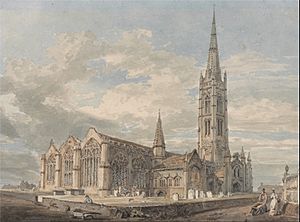
Middle Ages
The Domesday account notes Queen Edith having 12 carucates to the geld, with no arable land outside the village. She had a hall, two carucates and land for three ploughs without geld, and 111 burgesses. Ivo had one church and four mills rendering 12 shillings, and eight acres of meadow without geld. The lands of Bishop Osmond were described: "In Londonthorpe ... is land for two ploughs. This land belongs to the church of Grantham. In Spittlegate, St Wulfram of Grantham has half a carucate of land to the geld. In Great Gonerby, St Wulfram of Grantham has 1 carucate of land. There is land for twelve oxen."
On 4 December 1290, the funeral cortège of Eleanor of Castile, accompanied by her husband King Edward I, stopped at Grantham on its way from Lincoln to Westminster Abbey. An 'Eleanor Cross' was later erected in the town, although its precise location has not been identified.
In 1363 "The Castles, Manors and towns of Stamford and Grantham" were granted to Edmund of Langley, 1st Duke of York, and fifth son of Edward III of England. The question has been raised as to whether Grantham House was the site of a castle, however, no such site has been reliably identified. The street name "Castlegate" cannot be traced further back than the 17th century. There are references to a Hospital in Grantham as early as the 1330s.
Grantham received its Charter of Incorporation in 1463.
19th and 20th centuries
The town developed when the railway came to the town. The Nottingham Line (LNER) arrived first in 1850, then the London line (GNR) – the Towns Line from Peterborough to Retford – arrived in 1852. The Boston, Sleaford and Midland Counties Railway arrived in 1857.
The town received gas lighting in 1833. The corporation became a borough council in 1835. Little Gonerby and Spittlegate were added to the borough in 1879. The town had been in the wapentake of Loveden, and the town included three townships of Manthorpe with Little Gonerby, Harrowby, and Spittlegate with Houghton and Walton.
Grantham Golf Club (now defunct) was founded in 1894. The club continued until the onset of the Second World War.
Until the 1970s the housing estates west of the town centre were green fields. Green Hill, on the A52, was literally a green hill. In July 1975 the National Association of Ratepayers' Action Groups (NARAG) was formed in Grantham by John Wilks, its Chairman, being a forerunner of the TaxPayers' Alliance.
Military history
Dambusters
During the Dambuster Raids Royal Air Force missions in May 1943, the RAF Bomber Command's No. 5 Group and the operation HQ was in St Vincents, a building which was later owned by Aveling-Barford and housed a district council planning department. It was built by Richard Hornsby in 1865, lived in by Richard Hornsby's son, and is now a private house. In 1944 (including D-Day), this was the headquarters for the USAAF's Ninth Air Force's IX Troop Carrier Command, being known as Grantham Lodge. During the early part of the war Sir Arthur Harris, 1st Baronet lived in the town.
RAF Spitalgate
RAF Spitalgate trained pilots during both world wars, initially as a Royal Flying Corps establishment. It was the first military airfield in Lincolnshire. It has never been an operational fighter or bomber base; although it did see operational service during the 1943 invasion of Europe as a base for American and Polish gliders and parachutists. It officially closed in 1974. The WRAF had been there from 1960 until closure.
After closure RAF Spitalgate became the Territorial Army Royal Logistic Corps Prince William of Gloucester Barracks, named after Prince William of Gloucester. Grantham College used the site's two football pitches for their South Lincolnshire Football Development Centre (from September 2004). After closure in 1975 a Vehicle test centre was built on the outfield, which closed in 2011. The large mast on the base was part of the BT microwave network.
The Queen's Royal Lancers (part of the Royal Armoured Corps) have their RHQ on the base.
RAF Regiment
The RAF Regiment was formed just north-east of the town in parts of Londonthorpe and Harrowby Without during December 1941 with its headquarters at RAF Belton Park which is recognised as the birthplace of the Corps. The Belton Park estate had been the training centre for the Machine Gun Corps from November 1915. In total Belton Camp and Harrowby Camp housed 18,000 men during the First World War.
The RAF Regiment grew to in excess of 66,000 personnel, and during training were housed at RAF Belton Park, which was the Regiment's first depot, RAF Folkingham and RAF North Witham. The RAF Regiment stayed until August 1946, when it left for RAF Catterick.
Women's police force
Grantham is notable as being the first place in the world after London to recruit and train women police officers. Grantham was the first provincial force to ask the newly formed Corps of Women's Police Volunteers to supply them with occasional policewomen, recognising them as particularly useful for dealing with women and juveniles. In December 1914 Miss Damer Dawson, the Chief of the Corps, came to Grantham to supervise the preliminary work of the women police. The officers stationed at Grantham were Miss Allen and Miss Harburn. In 1915, Grantham magistrates swore in Mrs Edith Smith, making her the first proper policewoman in Britain with full powers of arrest.
Industrial history
Richard Hornsby & Sons
In 1905 Richard Hornsby (1790–1864) & Sons of Grantham (founded 1815) invented a caterpillar track for a machine using Hornsby's oil engines; these engines were developed by Yorkshireman Herbert Akroyd Stuart, from which compression-ignition principle the diesel engine evolved, being manufactured in Grantham from 8 July 1892. Although these engines were not wholly compression-ignition derived, later in 1892 a prototype high-pressure version was built at Hornsby's, developed by Thomas Henry Barton OBE - later to be the founder of Nottingham's Barton Transport, whereby ignition was achieved solely (100%) through compression; it ran continuously for six hours, being the first known diesel engine. In the town, Hornsby's built Elsham House (the grounds became Grantham College) and the Shirley Croft. Their site on Houghton Road was bought from Lord Dysart.
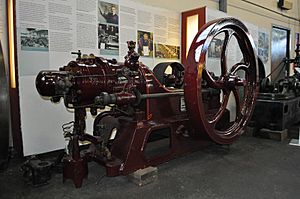
In 1909 Hornsby's showed the British Army their invention, who were bemused, but took the idea no further than that, although they subsequently bought four caterpillar tractors in 1910 to tow artillery. A short time later, Hornsbys sold the patent for the caterpillar track in 1914 to The Holt Manufacturing Company of California, USA for $8,000, having only sold one caterpillar tractor commercially. Hornsby's design was far ahead of anything else around at the time. Through ownership of the patent, this company became the successful Caterpillar Inc. Tractor Company. Benjamin Holt even claimed to be the real inventor. In December 1914 the British Army's Colonel Ernest Swinton saw one of Holt's caterpillar tractors towing a piece of artillery, and realised its potential as an attack vehicle. One year later the tank was born (using Hornsby's initial designs), being made in nearby Lincoln by William Foster. It first saw action at the Battle of Flers-Courcelette on 15 September 1916.
In 1918 Hornsby's amalgamated with Rustons and the company became Ruston & Hornsby. In the 1920s the company had their own orchestra in the town; the site was a diesel engine plant. During the Second World War, the company made tanks such as the Matilda at the Grantham factory. Ruston and Hornsby left in 1963 and most of the factory was taken over by a subsidiary, Alfred Wiseman Gears, who left in 1968.
Barford's
Aveling & Porter of Rochester, Kent, merged with Barford & Perkins of Peterborough to become Aveling-Barford Ltd in 1934, largely due to financial help from Ruston & Hornsby, when both companies had entered into administration. The new company took a former site of Hornsbys, naming it the 'Invicta' works, from the motto on the coat of arms of Kent, and translates as 'unconquered'; all Aveling & Porter machinery was brought from Kent by rail.
During the 1970s it was the town's largest employer with around 2,000 employees. It initially prospered, but with the sinking market for large dumper trucks and road rollers, it declined. Their agricultural division, Barfords of Belton, in 1947 developed the world's smallest tractor, the Barford Atom, weighing 177 lbs.
Now as Barford Construction Equipment, it makes dumpers for construction sites, being owned by Wordsworth Holdings PLC, owned in turn by the entrepreneur Duncan Wordsworth until it went into administration. In March 2010 Wordsworth Holdings went into administration. A restructuring package resulted in ownership transferring to Bowdon Investment Group in May 2010, and is known as Invictas Engineering.
A trailer company, Crane-Fruehauf, moved into part of the factory, from its former home at Dereham, when it went into receivership in early 2005.
BMARC
British Manufacture and Research Company (British Marc Ltd or BMARC), on Springfield Road, made munitions, notably the Hispano cannon for the Spitfire and Hurricane from 1937 onwards. It was owned by the Swiss company Oerlikon from 1971 until 1988, becoming part of Astra Holdings plc. The company was bought by British Aerospace in 1992, who afterwards closed the site which has now been developed as a housing estate. The site's former offices are now business units for the Springfield Business Centre. Grantham's register office was moved there in 2007.
Former developments
In 1968 Reads of Liverpool built a canning factory on Springfield Road. It made cans for Melton Mowbray, becoming American Can, then Pechiney (French) in 1988, then as Impress (Dutch) it was closed in 2006, demolished in 2007 and is now a housing estate. Ransome & Marles Bearing had a ball bearing factory in the town until 1957, when production was moved to Newark.
Mowbray and Co Ltd, a brewery, was bought by JW Green of Luton. It was founded in September 1828 and became a public company in 1880. It closed in 1967.
Geography
The town boundary crosses the A1 to the west at the Dysart Road bridge. North of there it lies to the east of the A1. It crosses the B1174 at Gonerby Hill. All of the Manthorpe estate is a part of the town, but the (smaller) Manthorpe village and the church are part of Belton and Manthorpe civil parish. The boundary then follows Green Lane, bordering the civil parish of Harrowby. It passes to the west of Harrowby Hall and over Hall's Hill. It then crosses the A52 at the start of Somerby Hill, borders Little Ponton, and crosses the B1174 at the southern end of the Spittlegate Level Industrial Estate.
According to Super Output Area data from the ONS, the least socially deprived area in Lincolnshire is the ward of Stamford St John's; Grantham's least deprived ward (SKDC) is in the north-east of the town near the former Central School.
Religion
The main local landmark is the parish church of St Wulfram's, which has the sixth highest spire (282.5 feet (86.1 m) high) among English churches. It is the second tallest church in Lincolnshire, after St James Church in Louth. It is also home to England's first public library, dating from 1598, when Francis Trigge, rector of Welbourn, gave £100 for a small chained library of books for the clergy and literate laity of Grantham. Two hundred and fifty of the original volumes remain and are kept in a small room above the South Porch. From October 1974 the church was permanently floodlit at night.
The Anglican church in the New Somerby district, dedicated to St Anne and seating about 350, was erected as a mission church in 1884 and built of iron. A mission church, dedicated to St Saviour and seating about 150, was built of brick in the Little Gonerby district in 1884. The Church of St John the Evangelist was built of stone in the Spittlegate district in 1840–41. It seated about 1,100. Today the Deanery of Grantham still includes the churches of St Anne and St John the Evangelist amongst its 18 churches. The suffagan Bishop of Grantham is currently Nicholas Chamberlain; his official residence is in Long Bennington.
St Mary's Catholic Church is located on North Parade. Grantham Baptist Church is located on Wharf Road. Grantham Christchurch LEP Church (United Reformed) is located on Finkin Street. Harrowby Lane Methodist Church dates from the late 1920s. Finkin Street Methodist Church was a Wesleyan Methodist chapel that was built in the 1840s and attended by Margaret Thatcher.
Plans to construct an Islamic cultural centre in the town in 2014 created some controversy, including protests from right-wing groups.
Culture and community
Traditions
The Grantham Parade and the Grantham Festival take place every year. There was an annual pig drive through the centre of the town until 1962, when it was deemed too dangerous; this tradition dated back to 1755, when pig farmers from the area moved pigs to greener pastures.
The Grantham Festival of Music began in 1963.
Nature
Grantham and its surrounding area is home to the peregrine falcons, which roost in the bell tower of St Wulframs Church, and the "Grantham Gobbler", a heron. Both of these birds are voracious predators.
Grantham is surrounded by rolling countryside and woodland, such as nearby Ponton Park Wood, which has walks and views of woods and farmland. To the north east of the town there are the attractive gardens and the magnificent deer park of the National Trust's Belton House. Adjacent to these are Londonthorpe and Alma Park Woods, both owned by the Woodland Trust. The former comprises young woodland and open areas of wild flowers, whilst Alma Park has some mature woodland on its steep limestone scarp and offers views over the town and the surrounding area.
To the south of the town, between Little Ponton and Saltersford, the River Witham flows through marshes and water meadows. These support a variety of plant species including vetches, cowslip, Primula veris, Lady's bedstraw {Galium verum}, and orchids, including the Southern Marsh Orchid, and wildlife, including herons, ducks, geese, water vole, and the now critically endangered white clawed crayfish. This area has notable populations of dragonflies, especially Aeshna grandis, Anax imperator, Libellula quadrimaculata and Calopteryx splendens, that are also found on Grantham Canal, which runs through The Vale of Belvoir to the west of the town. Wildlife can also be found in the town's Wyndham and Dysart Parks.
The Woodland Trust is based on Dysart Road and has been in Grantham since 1978; its new £6 million building, on the opposite side of the road, opened in November 2010. The building, designed by Atelier One and Max Fordham, has won several architectural awards.
Amenities for children
Wyndham Park has two children's play areas. There is an open air paddling pool, football pitch, skateboard park and cafe. Dysart Park has a paddling pool and safe play area for children under six, a green for football and a bandstand. Indoor amenities for children include a swimming pool at the Meres Leisure Centre. The public library is located in the Sir Isaac Newton Centre, which includes Grantham Museum and the Guildhall Theatre. There is also a Fun Farm on Dysart Road.
Organisations for young people include Army cadets (both QRL Queen's Royal Lancers and RLC) Brownies, Guides and Air Cadets.
Belton House is a popular National Trust site with events for children, a play area, train rides, picnic area and woodland walk.
Radio
There is a small FM radio transmitter near the town's bypass on Gorse Lane from which BBC Lincolnshire and Lincs FM broadcast. Most television programmes are broadcast from Waltham, between Grantham and Melton, due to the line of sight to Belmont being blocked by hills to the east of the town.
Grantham also has a full-time community radio station, Gravity FM, which broadcasts from its own transmitter, at The Maltings on Springfield Road, and also online. Following redevelopment, the station has its own studios, on Riverside Walk, at the western side of Grantham College. The station is operated by volunteers from the local area.
Grantham gingerbread biscuits
The town is known for gingerbread biscuits which were first made in 1740 by William Eggleston. Eggleston, a baker by trade, was a producer of a biscuit called Grantham Whetstones. Whetsones were a rusk like dry biscuit enjoyed locally and also by coach drivers who used to stop in Grantham to change their horses whilst travelling on the Great North road. According to folklore, Egglestone, whilst baking whetsones in his dimly lit kitchen one morning, mistook one ingredient for another, resulting in a ginger-like biscuit to emerge from the oven. The mistake was a huge success and the biscuit became established as Grantham gingerbread, known as a white gingerbread because it is not made with molasses or black treacle. This provides a delicate ginger flavour, rich in butter, with a domed top that has a crackled surface. The centre is hollow and resembles a honeycomb.
Grantham Journal
Grantham's local newspaper, The Grantham Journal, first went on sale in 1854 as The Grantham Journal of Useful, Instructive and Entertaining Knowledge and Monthly Advertiser, which was shortened to its current name a few years later.
David Wood CBE (1914–1990), former political editor of The Times (working under Sir William Haley), started out at the Grantham Journal.
Transport
Rail

Grantham railway station is served by the London–Edinburgh East Coast Main Line, between Peterborough and Newark Northgate). It is joined by the Nottingham to Skegness Line (Poacher Line). Liverpool–Norwich trains also call at Grantham. Electric trains began running in October 1988. Transport links to Nottingham and Peterborough attract some commuters. The town's grammar schools also attract pupils from Radcliffe on Trent, Bingham, Newark and even Retford via the train. Grantham is the best-served station in Lincolnshire, although after October 1970, most of Lincolnshire's branch lines were closed. Before October 1970 the connection from King's Cross to Lincoln Central was through Grantham and followed the A607 via Leadenham. After that date, London-Lincoln trains still passed through Grantham, but then continued up the main line to Newark Northgate, where the trains branched off to Lincoln St Marks Railway Station via a new curve just north of Newark.
In 1906 a rail accident killed 14 people.
On 3 July 1938 Mallard broke the world speed record for steam locomotives, at 126 mph (203 km/h), on the slight downward grade of Stoke Bank south of Grantham on the East Coast Main Line.
Road
The Great North Road was routed through the town in 1196. The turnpike to the north reached the town in 1725, that to Stamford in 1739, to Nottingham in 1758, and that to Melton in 1780.
The A1 main road from London to Edinburgh runs past the town, which was bypassed in 1962. The A52 linking Nottingham and the East Coast was diverted from High Street onto the Inner Relief Road, Sankt Augustin Way, in 1998. Wharf Road and London Road junction is still a busy junction on the A607 for Lincoln. Motorway-style Grantham North Services, at the north end of Grantham bypass, is on a new junction which replaced a roundabout in May 2008.
Grantham, with Stamford, had been earmarked for a bypass before the war in 1939. There were 60 serious accidents a year, with three to four deaths. After the war, on 21 November 1945, there was a meeting at the Guildhall about the proposed bypass of the London-Edinburgh-Thurso trunk road for Grantham and Great Gonerby. This was the first enquiry into a trunk road scheme in the country after the war. The proposed route followed the current line, from Little Ponton to College Farm, except it was to be a single carriageway road.
On 8 February 1960, it was announced that a bypass would be built, including the route south to the B6403 at Colsterworth. Robert McGregor and Sons Ltd of Manchester would build the road for £1,856,009. (The company went on to build Newark bypass in 1964.) The bridges were built by Simon Carves of Cheadle Hulme. It was formally opened on 10 October 1962 by James Heathcote-Drummond-Willoughby, 3rd Earl of Ancaster, then the Lord Lieutenant of Lincolnshire (from 1950 to 1975). He was married to the (only) daughter of Nancy Astor.
Various attempts at one-way systems in Grantham have been introduced, but traffic delays are still commonplace. Low railway bridges also add to traffic difficulties, with lorries becoming stuck under them. Many promises have been made by the local council for a Grantham bypass road. The latest, the Grantham Southern Relief Road, has been in planning since 2007. Phase one of the project was completed in 2016. Phase Two, started in October 2019, involves a new junction on the A1 and is due to be completed by Autumn 2021. Phase three for the main stretch of road is due to start in 2021 and be completed by 2023
Waterways
Grantham was once linked to Nottingham by the Grantham Canal. It is possible to walk and cycle along the canal starting from Grantham near the A1/A607 intersection (opposite The Farrier).
The River Witham runs through Grantham. It has a riverside walk linking Dysart Park and Wyndham Park, on which is a view of Spittlegate Mill. The walk passes Inner Street allotment and the rear of Sainsbury's car park, access to which is by a pedestrian bridge at the end of College Street. There are other footbridges with views of the river and its weirs. Swans, ducks and trout are among the wildlife that can be seen along the river.
Landmarks
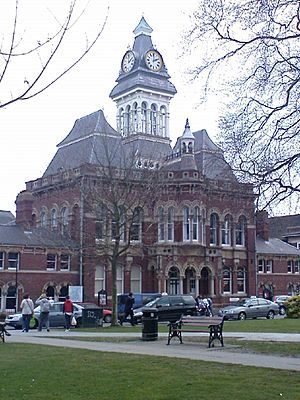
Grantham House is to the east of the church, and a National Trust property.
Grantham has the country's only 'living' public house sign: a beehive of South African bees situated outside since 1830.
Edith Smith Way is a road next to the Guildhall Arts Centre, on St Peter's Hill; it is named after England's first policewoman. Mary Allen and Ellen F. Harburn reported for duty on 27 November 1914. Mary Allen was a former suffragette and had been previously arrested outside the House of Commons and later went on to be the commandant of the UK's women's police force from the 1920s up to 1940. She helped to set up women's police forces in other countries, including Germany. Edith Smith became the first female with powers of arrest in August 1915.
Sandon Road is named after Viscount Sandon, also the Earl of Harrowby. The first person with the title was Dudley Ryder, 1st Earl of Harrowby; a road is also named after him. He purchased Harrowby Hall in 1754. The current incumbent is Dudley Ryder, 8th Earl of Harrowby.
The Blue Pig, one of many Blue pubs, is situated on Vine Street, near the Church of St Wulfram. The building is one of probably only four remaining Tudor buildings in the town and is a survivor of the disastrous fires of the 1660s.
The nearby George Hotel (known as St Peter's Place, now the George Shopping Centre) was mentioned in Charles Dickens's novel Nicholas Nickleby. Much of the town's property and industrial estates have been owned by Buckminster Trust Estates since the time of the Earl of Dysart.
To the west of the town, near the A607, is Baird'smaltings, formerly owned by Moray Firth until 1999, and before that, R & W Paul. Other maltings in the town have been converted for residential use such as Riverview Maltings near the river and formerly owned by Lee & Grinling's.
The JobCentre, when it was opened on 24 June 1975 by Joe Godber, was the first of around 500 labour exchanges run by the Employment Service Agency, with soft chairs and carpets.
Nearby are many historic houses including 17th-century Belton House (the Brownlows), early 19th-century Harlaxton Manor (the Gregorys), Stoke Rochford Hall (owned by the Turnors, and since 1978 is now the training centre of the NUT), and the 11th-century Belvoir Castle (the Manners), in Leicestershire. Much of the property and land to the south-west of the area is owned by the two estates of Belvoir and Buckminster. Further to the south of Stoke Rochford are the Cholmeleys of Easton Hall.
Twinning
 - Sankt Augustin, North Rhine-Westphalia, Germany (near Bonn, 57,000 population), twinned since 1980. The A52 relief road is named Sankt Augustin Way. Sankt Augustin has its Grantham-Allee and "Grantham-Bridge".
- Sankt Augustin, North Rhine-Westphalia, Germany (near Bonn, 57,000 population), twinned since 1980. The A52 relief road is named Sankt Augustin Way. Sankt Augustin has its Grantham-Allee and "Grantham-Bridge".
Economy
The food industry, together with Grantham Hospital, is currently the largest Grantham employer. Poultry production company Moy Park (formerly Padleys) is at Gonerby Hill Foot; GW Padley bought the site in 1977 from Wolsey, a former garment manufacturer. It acts as a poultry hatchery. Moy Park are owned by Marfrig of São Paulo, with Marfrig's European headquarters at Preston Deanery in Hackleton, Northamptonshire. Aviagen Turkeys also has a poultry hatchery further along the B1174 at Gonerby Moor. Brake Bros Ltd has a depot near the Gonerby Moor service station, off B1174.
Fenland Foods (part of Northern Foods) on the Earlesfield Industrial Estate, closed in September 2008 after losing business with Marks and Spencer, its sole customer. On Ellesmere Business park is Väderstad-Verken UK, its parent company based in Väderstad in Sweden and Tecknit Europe (makers of electromagnetic shielding equipment), owned from 2006 by Parker Hannifin based in Cranford, New Jersey.
At Easton, 7 miles (11 kilometres) south of Grantham, are two large facilities. One is Norbert Dentressangle, which bought Christian Salvesen plc in November 2007 and maintains the frozen storage and distribution operation which has been at the site since the late 1960s. The other is McCain Foods, which purchased Potato and Allied Services (PAS) in 1991, which had run a potato processing factory on the site since the early 1970s; it has since been extended. There was a third large frozen vegetable processing factory owned and operated by Christian Salvesen; it was sold to Pinguin Foods in August 2007, which closed the facility in December 2008.
GBS has been based in Grantham since May 1975, when known as Chatto, Bodley Head & Cape Services. Chatto & Windus had merged with Jonathan Cape in 1969. The former site was officially opened on 23 September 1975 by Michael Foot MP. Random House was formed in 1987 from a combination of book companies, and in 1990 the site became known as Grantham Book Services. The company won an award in 1992 from the British Book Awards. Next door to GBS and a Gala Bingo is Cathodic Protection, which with BGB Innovation won The Queen's Award for Enterprise: International Trade (Export) in 2009.
According to Super Output Area data from the ONS, the least socially deprived area in Lincolnshire is the ward of Stamford St John's; Grantham's least deprived ward (SKDC) is in the north-east of the town near the former Central School.
Hotels
Conference and hospitality facilities in the Grantham area include the Olde Barn Hotel in Marston, the Q-Hotel group Belton Woods Hotel, the Urban Leisure Hotel and various golf clubs. Stoke Rochford Hall won the Les Routiers Wedding Venue of the Year in 2011. The Griffin Inn at Irnham won the 2012 Les Routiers B&B of the Year Award. The Eden House Hotel is a historic building built as a mansion in about 1850.
Angel and Royal
The Angel and Royal in the High Street is widely regarded as the oldest surviving English inn. The façade of the main building as it appears today was built about 600 years ago, but the site had already held an inn for 200 years. It was originally a hostel for the Knights Templar. King John is reputed to have visited with his Royal Court in 1213. The inn was extended in the mid-14th century and again in the 15th century.
A visit by Richard III was the origin of the gold emblem angel holding the King's crown over the original archway. In 1483 Richard held court and it was from the "Chambre de' Roi", that he dispatched a letter bidding for the Great Seal to proclaim the treachery of his cousin, the Duke of Buckingham, leading to the signature of Buckingham's death warrant. Copies of the letter, the original of which is kept by the British Museum, are displayed adjacent to the Richard III lounge and the King's Room Restaurant.
King Charles I made use of the King's Room during his visit in 1633 and Oliver Cromwell also stayed at the Angel after his successful battle near Grantham in 1643. The cellars and foundations of the inn are reputed to date from the 9th century, and are rumoured to be linked by tunnels to both St Wulfram's Church and the town's Market Square. In 1707 the then landlord Michael Solomon died, but left a legacy of 40 shillings a year to pay for the preaching of a sermon, against the evils of drunkenness, for every Mayor.
The prime position of the inn on the Great North Road led to its long history as a coaching inn, which accounts for its characteristic layout, with long courtyard, old stables and entrances to front and rear. In 1800 six inns were listed in Grantham, together with 21 alehouses. The Angel's prosperity declined markedly with the coming of the railways.
By the middle of the 19th century, the Angel had also enjoyed the patronage of King George IV. In 1866 the then Prince of Wales visited Grantham, directly leading to the second part of the inn's name. In the early 1920s the word Inn was dropped and the building became a hotel.
After the Second World War, the hotel was purchased by Trust House Hotels, later to become Trust House Forte. It remained with Trust House until a few years ago. Since then there has been a succession of owners, including several brewery companies. In May 2002, the Angel and Royal was purchased by a consortium of local business professionals.
Closures
Brook Street and Hill Avenue sub-post offices were closed in Grantham in 2008 as part of the Post Office Network Change programme. In August 2010 it was confirmed that the Grantham branch of Marks and Spencer would close, with two other Lincolnshire branches in Skegness and Scunthorpe, due to low sales, although a Marks and Spencer Food Hall re-opened in 2014. The closure met with local protests. Discount department store chain Boyes took over the property in 2012. Haldanes, a chain of about 20 supermarkets based in Ruston Road, went into administration. The former HMRC office at Crown House in Castlegate closed in early 2010, moving to two sites in Lincoln.
Sport
Football
Grantham Town Football Club, the local football team, currently plays in the Evo-Stik Northern Premier League. It was founded in 1874 and now uses the 7,500-capacity (covered 1,950, seats 750) South Kesteven Sports Stadium (although average attendances are well below that). The ground also doubles as the town's athletics stadium (one of only three in Lincolnshire), next to the Grantham Meres Leisure Centre on Trent Road.
Harrowby United F.C. in Dickens Road, near the Church of the Ascension, is in the UCL (United Countries League) Division One league.
Rugby Union
Kesteven Rugby Football Club was founded in 1947 and plays at Woodnook, off the B6403. It fields two men's teams, a ladies XV and many junior sides.
Hockey
Grantham Hockey Club, which fielded men's and women's team in league hockey, played at the Meres Leisure Centre, on an astro-turf pitch directly behind the football stadium. In 2011, the men ended a long spell in the Midlands League, moving to the East League, successfully earning promotion to Division 5 (North West). Their story is documented in 1,309 Days Later, the title a reference to a no-win spell between 2006 and 2009.
Bowls
Grantham bowls players have represented the indoor and outdoor clubs in county and national competitions. Indoor club players Martin Pulling, Dion Auckland, Ian Johnson, and former England U25 player Mathew Orrey, have played for the England squad.
Table tennis
In 1993 and 1994 international team matches were held in Grantham, at the South Kesteven Table Tennis Centre, which was opened in January 1992 by Johnny Leach. Grantham College have a Table Tennis Academy.
Education
Grantham College, a further education college for the district, opened in 1948, for those not attending school sixth forms. It has a satellite site at Sleaford, Sleaford College. Since September 2008 the Walton Academy in Kitty Briggs Lane near Harlaxton Road has run post-16 courses as Grantham's only sixth form college. In September 2019, the school had its first intake of male students in the lower school, making the former all-girls school co-educational.
Two notable schools in the district are Kesteven and Grantham Girls' School and The King's Grammar School. Both have large sixth forms and eminent past students. Britain's first female Prime Minister, Margaret Thatcher, attended Kesteven and Grantham, and Isaac Newton famously attended The King's. Both have remained single-sex up to the age of 16.
In 1970, Kesteven County Council (based in Sleaford) announced plans to turn the grammar schools into co-educational comprehensives for ages of 11–16 and leave Grantham College the only sixth form for the town. Later it was proposed to create two sixth-form colleges from one of the grammar schools. Other parts of Kesteven became comprehensive but responsibility for education passed to Lincolnshire under the local government reorganization of 1974, and both schools stayed as grammar schools. Ex-pupil Margaret Thatcher was education secretary at the time. The governors of the King's School delayed the process in July 1973, and in January 1975 a plan to make Grantham comprehensive was voted against by the county council, having been approved by the council's own education committee.
On 1 August 2011 The King's School ended its long relationship with the local elected authorities and the town of Grantham, by converting to a selective academy. It remains a selective boys' school and has kept its name and logo.
All four secondary modern schools are on the outskirts of Grantham. Only three of the six secondary schools are co-educational.
The Priory Ruskin Academy (formerly Central Technology & Sports College) is a co-educational school sited near Manthorpe.
In Gorse Lane is Grantham Preparatory School, an independent school preparing entrants for the 11-plus examination. Another private primary school is Dudley House School. Near St Wulfram's on Castlegate is the National Church of England Junior School, built in 1859, and a feeder school for the town's grammar schools.
The Blessed Hugh More School, a Catholic secondary school, closed in 1989.
Notable people

Arts and entertainment
- Antonio Berardi (born 1968), fashion designer
- Judy Campbell (1916–2004), actor and playwright
- Syd Cain (1918–2011), film production designer
- Eric Chappell (born 1933), comedy writer
- Colley Cibber (1671–1757), actor, playwright and poet laureate, attended The King's School, Grantham.
- Dorothy Cowlin (1911–2010), novelist born in Grantham
- Johnny Haddon Downes (1920–2004), television producer
- Vince Eager (born 1940), singer
- Graham Fellows (born 1959), actor and musician
- Michael Garner (born 1954), actor
- Holly Humberstone (born 1999), singer and songwriter
- Henry Johnson (1806–1910), circus equestrian gymnast and acrobat
- Jessie Lipscomb (1861–1962), sculptor
- Nicholas Maw (1935–2009), composer
- Richard Nauyokas (born 1962), soldier and actor
- Nicholas Parsons (1923–2020), television and radio presenter
- Roy Petley (born 1951), Grantham-born plein air painter
- William Stukeley (1687–1765), antiquarian
- Richard Todd (1919–2009) actor
- Clare Tomlinson (born 1968), news presenter
Religion
- Frederic Barker (1808–1882), Anglican Bishop of Sydney, attended The King's School.
- Tim Ellis (born 1953), Anglican suffragan Bishop of Grantham (2006–2013)
- Arthur Greaves (1873–1960), Anglican suffragan Bishop of Grantham and later Grimsby
- Gregory Hascard (died 1708), Anglican Dean of Windsor and religious writer
- Dennis Hawker (1921–2003), Anglican suffragan Bishop of Grantham (1972–1987)
- John Hine (1857–1934), Anglican bishop, successively of Nyasaland, Zanzibar, Northern Rhodesia and Grantham (1920–1930)
- Welbore MacCarthy (1840–1925), Anglican Archdeacon of Calcutta, and later inaugural suffragan Bishop of Grantham (1905–1920)
- Algernon Markham (1869–1949), Anglican suffragan Bishop of Grantham (1937–1949)
- James McCann (1897–1983), Anglican Archbishop of Armagh and Primate of All Ireland
- Anthony Otter (1896–1986), Anglican suffragan Bishop of Grantham (1949–1965)
- John Still (1593–1608), Bishop of Bath and Wells, once thought to have written an early farce, Gammer Gurton's Needle
- Doris Stokes (1920–1987), spiritualist and psychic medium
- William Wand (1885–1977), Anglican prelate, successively Archbishop of Brisbane, Bishop of Bath and Wells and Bishop of London
Science and engineering
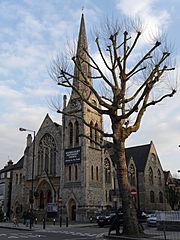
- Charles Bell (1846–1899), architect
- William Clarke (1609–1682), apothecary and tutor to Isaac Newton
- Maxwell Hutchinson (born 1948), architect
- Isaac Newton, (1642–1726/27), physicist and mathematician
- Mark A. O'Neill (born 1959), biologist and computer scientist
- Thomas James Smith (1827–1896), pharmacist and founder of the medical equipment firm Smith & Nephew
Sports
- Patrick Bamford (born 1993), professional footballer with Leeds United and the England national football team
- Terry Bly (1935–2009), professional footballer, died in Grantham
- Ian Bowyer (born 1951), professional footballer
- Roderick Bradley (born 1983), American footballer
- John Broughton (1873–1952), first-class cricketer
- Charles P. Dixon (1873–1939), Olympic gold, silver and bronze medal-winning tennis player
- Mathew Dowman (born 1974), first-class cricketer
- Dave Gilbert (born 1963), professional footballer
- Arthur Green (1885 – post-1912), professional footballer
- Timothy Grubb (1954–2010), Olympic show jumper
- Cyril Hatton (1918–1987), professional footballer
- Richard Holmes (born 1980), professional footballer
- Richard Howitt (born 1977), first-class cricketer
- Vikki Hubbard (born 1989), international high jumper
- Dickie Joynes (1877–1949), professional footballer
- Alastair McCorquodale (1925–2009), Scottish athlete and first-class cricketer, died in Grantham.
- Harry Pringle (1900–1965), professional footballer, died in Grantham.
- Arnold Rylott (1839–1914), first-class cricketer
- Simon Terry (1974–2021), Olympic Bronze medal-winning archer
- Tom Wells (born 1993), first-class cricketer
- William Woof (1858–1937), first-class cricketer
- Ashley Wright (born 1980), first-class cricketer
- Luke Wright (born 1985), first-class cricketer
Images for kids
See also
 In Spanish: Grantham para niños
In Spanish: Grantham para niños


